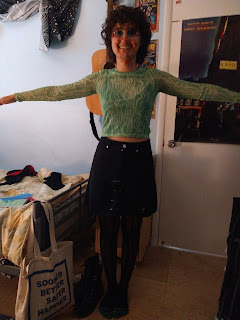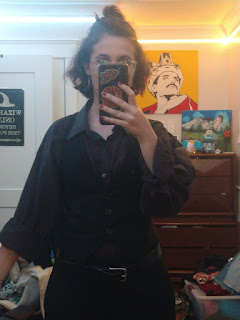Creative Critical Reflection
1. My music video challenges the convention of a seemingly innocent, kid friendly video turned adult and bloody. The music itself is very cheery with deadly lyrics, which is made to reflect the actions taking place in the video. The normality of Radio Star and Video waking and starting their day the same way is part of the deception of what is to come. As the video continues on, the shot of Video putting on the glove is made to be a foreshadowing of sorts. When the scene of Video killing Radio Star occurs, we can see that this “PG” music video has turned “R”. This is made to represent Hollywood censorship and their tendency to put a pretty picture in front of an ugly scene, just like the cheerful music is made to cover the bloody actions. Secret societies, NDA parties, and mafia deals is what Hollywood tries to mask with tv shows and films made to distract us. Censorship over “not happy and distracting” media, like ours, is what people and especially mothers shielding their child from the world wants Hollywood to do. This was the reality of many Hollywood films during and post-WWII, however, now is made to distract people from serious social and environmental issues. My music video also includes elements of older artists being pressured to convert to the newer times by violence or elimination. However, the biggest issue that my music represents is deadly Hollywood censorship.
2. The main way my video engages audiences is by nostalgia. The low quality visuals and filters remined people of music videos from the 70s and 80s and things kids would watch on MTV. This sense of visual nostalgia with the happy sounding song from 1980 reminds people of a happier, less stressful time. I also believe that the parallel between Video and Radio Star getting ready in the morning creates that carefree mood that encapsulates audiences and leaves their eyes glued to the screen. The backing vocals during the chorus that repeats “video killed the radio star” acts like a sing-a-long and encourages audience to sing with the music video. In the modern day this music video would be available for streaming on Hulu, Prime Video, and Apple TV as well as the classic YouTube. Many social media platforms allow you to share and post videos, so logically my music video would be able to be posted and viewed there as well.
3. Adaptability was a skill fostered during the filming of my music video and the production reflects that. Instead of filming the shots on a tripod or by holding it still at chest height, I was forced to lay down on the floor, stand over my friend and lean way over her, and put the camera uncomfortable close to my face in order for the actors to be in the correct positioning. Adapting to certain shots, angles, and completely making something on the spot was a major part of filming the music video. A lot of thought also went in with the costumes as Radio Star had to dress up in very formal, 50s style clothing, while Video had to look very futuristic. Videos costume had to pay homage to the character in the original music videos silver outfit, without owning a single piece of silver clothing. Furthermore, even with a seemingly straight forward filming scheduled, people still bailed and weren’t available for filming because of strict parents. This is why my partners friend, Jack, had to take the place of the two original female backup singers. Even during editing I had to adapt to the Cap cut on the school computer glitching and not being able to edit or insert sound properly. I do believe that everything going wrong and forcing me to put more effort and thought into the production caused the end result to be better than expected. Overall, I learned to expect things to fail and to be prepared when they do.
4. During filming, I relied on technology such as phones, LED lights, and mini microphone props. Everything was filmed with my partner's phone while song playbacks were played on my phone and my friend, Constanza’s, phone. For parts where the actors had to sing along to the song (Radio Star in the sound booth and Video at the end) the actual song had to be played on someone else's phone, so they mouthed the lyrics at the same speed. This was a crucial part in those scenes as if the timing was wrong it would cause the entire shot to be a failure. Filming was also reliant on the LED lights in my partners room for the scenes of Video getting ready as they were the main source of light. During editing, I mainly utilized Capcut and TikTok. Capcut, as always, was used as the editing grounds where shots were exported, trimmed, and sped up to fit the time frame. I also used the application to insert the actual music via download and trimmed it up, so it fit the scenes and lined up. I had to save the original music video from TikTok and send it to my email where I downloaded onto my computer. Then I inserted two versions on Capcut so I could edit out the middle part and make the second verse and end mash together. This is how I used technology in my music video production.



Comments
Post a Comment